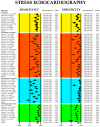Diagnostic Accuracy of Exercise Stress Testing, Stress Echocardiography, Myocardial Scintigraphy, and Cardiac Magnetic Resonance for Obstructive Coronary Artery Disease: Systematic Reviews and Meta-Analyses of 104 Studies Published from 1990 to 2025
- PMID: 40943997
- PMCID: PMC12429821
- DOI: 10.3390/jcm14176238
Diagnostic Accuracy of Exercise Stress Testing, Stress Echocardiography, Myocardial Scintigraphy, and Cardiac Magnetic Resonance for Obstructive Coronary Artery Disease: Systematic Reviews and Meta-Analyses of 104 Studies Published from 1990 to 2025
Abstract
Background: Since the 1990s, numerous investigations have assessed the diagnostic effectiveness-specifically sensitivity, specificity, and accuracy-of exercise stress testing (EST), stress echocardiography (SE), stress myocardial single-photon emission computed tomography (SPECT), and stress cardiac magnetic resonance imaging (CMR). However, the outcomes of these studies have often been inconsistent and inconclusive. To provide a clearer comparison, we conducted systematic reviews and meta-analyses aimed at quantitatively evaluating and comparing the aggregated diagnostic performance of these four commonly used techniques for detecting coronary artery disease (CAD). Methods: A comprehensive search of PubMed, Scopus, Embase, Cochrane Library, and Web of Science was conducted to identify cohort studies evaluating the diagnostic accuracy of EST, SE, stress myocardial SPECT, and stress CMR in symptomatic patients with suspected or confirmed CAD. The main goal was to compare their diagnostic value by pooling sensitivity and specificity results. Each study's data were extracted in terms of true positives, false positives, true negatives, and false negatives. Results: A total of 104 studies, comprising 16,824 symptomatic individuals with either suspected or known CAD, met the inclusion criteria. The pooled sensitivities for CAD detection were 0.66 (95% CI: 0.59-0.72, p < 0.001) for EST, 0.81 (95% CI: 0.79-0.83, p < 0.001) for SE, 0.82 (95% CI: 0.78-0.85, p < 0.001) for stress myocardial SPECT, and 0.83 (95% CI: 0.81-0.85, p < 0.001) for stress CMR. Corresponding specificities were 0.61 (95% CI: 0.55-0.67, p < 0.001), 0.85 (95% CI: 0.82-0.87, p < 0.001), 0.74 (95% CI: 0.70-0.78, p < 0.001), and 0.89 (95% CI: 0.86-0.92, p < 0.001), respectively. Considerable heterogeneity was observed across the studies, as reflected by I2 values ranging from 82.5% to 92.5%. Egger's generalized test revealed statistically significant publication bias (p < 0.05 for all methods), likely due to the influence of smaller studies reporting more favorable results. Despite this, sensitivity analyses supported the overall robustness and reliability of the pooled findings. Conclusions: Among the diagnostic tools assessed, EST demonstrated the lowest accuracy for detecting obstructive CAD, whereas stress CMR exhibited the highest. Although stress myocardial SPECT showed strong sensitivity, its specificity was comparatively limited. SE emerged as the most balanced option, offering good diagnostic accuracy combined with advantages such as broad availability, cost-effectiveness, and the absence of ionizing radiation.
Keywords: coronary artery disease; diagnostic accuracy; exercise stress testing; meta-analysis; myocardial SPECT; stress CMR; stress echocardiography.
Conflict of interest statement
Andrea Sonaglioni, Alessio Polymeropoulos, Massimo Baravelli, Gian Luigi Nicolosi, and Michele Lombardo declare no conflicts of interest. Giuseppe Biondi-Zoccai has consulted, lectured, and/or served as an advisory board member for Abiomed, Advanced Nanotherapies, Aleph, Amarin, AstraZeneca, Balmed, Cardionovum, Cepton, Crannmedical, Endocore Lab, Eukon, Guidotti, Innovheart, Meditrial, Menarini, Microport, Opsens Medical, Synthesa, Terumo, and Translumina, outside of the present work.
Figures
















References
-
- GBD 2017 Causes of Death Collaborators Global, regional, and national age-sex-specific mortality for 282 causes of death in 195 countries and territories, 1980–2017: A systematic analysis for the Global Burden of Disease Study 2017. Lancet. 2018;392:1736–1788. doi: 10.1016/S0140-6736(18)32203-7. - DOI - PMC - PubMed
-
- Safiri S., Karamzad N., Singh K., Carson-Chahhoud K., Adams C., Nejadghaderi S.A., Almasi-Hashiani A., Sullman M.J.M., Mansournia M.A., Bragazzi N.L., et al. Burden of ischemic heart disease and its attributable risk factors in 204 countries and territories, 1990–2019. Eur. J. Prev. Cardiol. 2022;29:420–431. doi: 10.1093/eurjpc/zwab213. - DOI - PubMed
-
- Khan M.A., Hashim M.J., Mustafa H., Baniyas M.Y., Al Suwaidi S.K.B.M., AlKatheeri R., Alblooshi F.M.K., Almatrooshi M.E.A.H., Alzaabi M.E.H., Al Darmaki R.S., et al. Global epidemiology of ischemic heart disease: Results from the Global Burden of Disease Study. Cureus. 2020;12:e9349. doi: 10.7759/cureus.9349. - DOI - PMC - PubMed
Publication types
LinkOut - more resources
Full Text Sources
Research Materials
Miscellaneous

